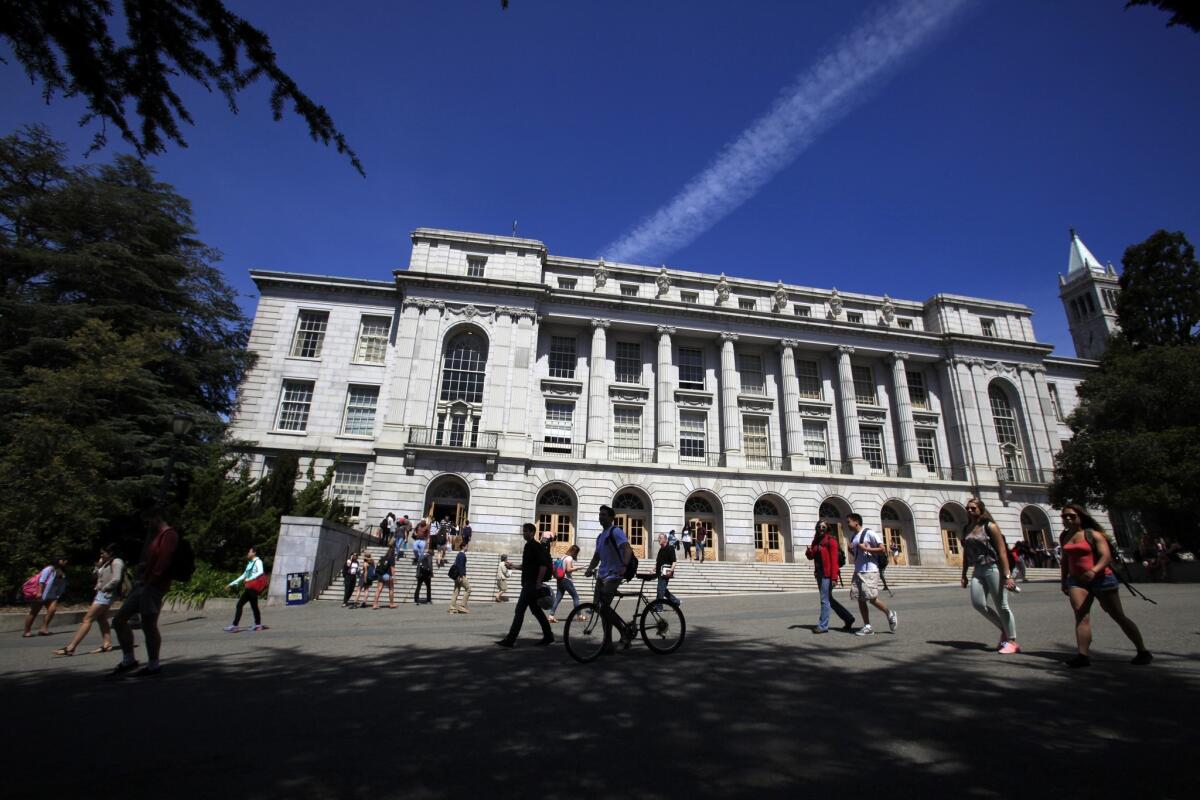UC admits largest and most diverse class ever of Californian freshmen

- Share via
The University of California opened its doors to the largest and most diverse class of Californians ever for the fall semester of 2019, according to preliminary data released Monday.
The system’s nine undergraduate campuses offered seats to 71,655 California freshmen, nearly 600 more students than last year. Overall, UC admitted 108,178 freshmen among 176,695 freshman applicants. It also admitted 28,752 transfer students from a pool of 41,282, including the largest-ever class from the California Community Colleges.
Overall, the system admitted 991 more students from underrepresented groups, increasing their proportion among California freshmen to 40% from 38% last year. First-generation students made up 44% of those admitted and low-income students 40%.
Asian Americans remained the largest ethnic group at 35%, followed by Latinos at 34%, whites at 22%, African Americans at 5% and American Indians at 0.5%.
“Yet another year of record-setting admissions underscores the tremendous interest in the world-class education at UC,” President Janet Napolitano said in a statement. “The best and the brightest young minds continue to make UC their university of choice.”
Adriana Lugo was one of the students to earn admission to UC Irvine, now the most popular campus for Californians. When she opened her email with the offer this spring, she said she burst into tears — as did her parents, both restaurant workers from Mexico.
Lugo, 18, will be first in her family to attend a four-year university. She credited her parents for motivating her with their constant reminders that education is key to a better future. UC Irvine was her first choice, she said, because of the beauty of the campus and its top-notch program in chemistry, her intended major.
“It’s like, crazy,” said Lugo, who graduated from George Washington Preparatory High School in South Los Angeles. “I was really happy because UC Irvine is my dream school. “
One of her classmates, Faith Okafor, is headed to UC Santa Barbara, where she hopes to enroll in a five-year program to earn both undergraduate and graduate degrees in computer science and engineering. She said the financial aid package, which will cover nearly all tuition and housing costs, was a key reason she accepted the admission offer. An immigrant from Nigeria, Faith said she hopes to start her own company and use her knowledge and skills to help lift up her African homeland.
Campuses varied widely in their admission offers. UCLA, UC Irvine and UC Santa Barbara reduced the number of offers to California students, but that doesn’t mean fewer students will end up enrolling at their campuses. UCLA and UC Irvine both said more students are accepting their offers, so they’re extending fewer of them to hit their final enrollment targets. UCLA is actually increasing seats for California freshmen by 240 this fall for a first-year class of 4,440, while UC Irvine plans to stay the same as last year with 4,500 in-state students.
The art of managing admissions and enrollment can be perilous. In 2017, UC Irvine created a statewide uproar when it admitted too many students and then rescinded 500 offers just two months before the fall term began. The campus ultimately reversed course and readmitted most of the students.
The UC system had been under pressure from state legislators to enroll more Californians after that group’s freshman admission rates fell from 85% in 2009 to 59% in 2018. UC campuses were hit by steep state budget cuts at the same time that applications from would-be freshmen and transfer students nearly doubled — from 127,755 in 2009 to 223,478 last year.
Controversy over rising numbers of students from other states and countries prompted the UC regents to implement a cap in 2017. In the latest data, UC campuses reduced their admissions offers to nonresident freshman applicants by 418 to 36,513 for fall 2019.
UC has enrolled nearly 15,000 additional California undergraduates in the last decade — and is set to admit an additional 4,860 students in the next two years — but still has not returned to previous per-student funding levels from the state. As a result, campuses are struggling with crowded classrooms, a rising faculty-to-student ratio, and deteriorating buildings and facilities.
Those pressures may ease up in the coming years if a national trend toward declining college enrollment hits the West Coast.
For the first time in 15 years, UC freshman applications for the coming school year dipped by 3%, according to preliminary UC data. Among the system’s nine undergraduate campuses, only three — UCLA, UC Berkeley and UC Santa Cruz — saw declines in freshman applications.
The drop could be a temporary blip triggered by wildfires and other natural disasters that could have made it harder for students to apply, experts said. Or it could be the start of a gradual decline as the number of high school graduates decreases, immigration policies tighten up and more students start at community college under a new state tuition waiver.
Another possibility is that students are applying to fewer campuses after years of doing the opposite, said Youlonda Copeland-Morgan, UCLA vice provost of enrollment management.
Nathan D. Grawe, a Carleton College professor of economics and social sciences, and author of “Demographics and the Demand for Higher Education,” has predicted that the number of California students who attend college will drop by 15% overall by 2029. The prediction includes a reduction of 17% for those who attend community colleges, but only 6% for those who attend the nation’s top 50 universities, including UCLA, UC Berkeley, UC Santa Barbara, UC Irvine, UC Davis and UC San Diego.
He said California will fare better than other states, however, because of rising parent education levels and the growing Asian American population.
More to Read
Sign up for Essential California
The most important California stories and recommendations in your inbox every morning.
You may occasionally receive promotional content from the Los Angeles Times.











